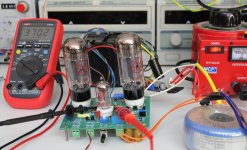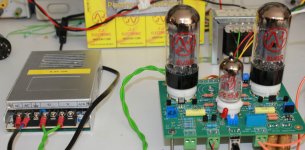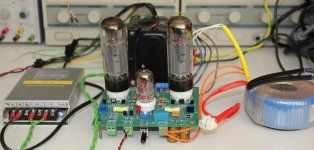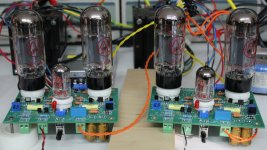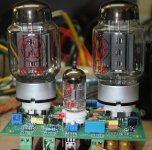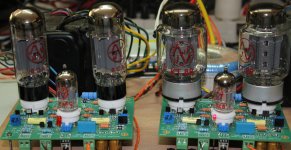I've been working on drafting out and studying the #602 Baby huey, and one thing I can't seem to figure out is what the input impedance and capacitance of the input stage are. I've seen some sources that say that it's just the value of the grid resistor, but 1K5 seems like a really low input impedance, I'm used to seeing them more over 1megohm. The reason i'm asking this is that I already have an amplifier, and am going to upgrade my preamp before I upgrade my amp. I've been in contact with Ale Moglia of Bartola valves regarding whether I should use a source follower or not. At the end of the day, what I want to know is whether a pair of 01A DHT's will be able to drive the input stage of the Baby Huey monoblocks, or whether I need to add a source follow?
P.S. Because there's no input transformer, I shouldn't be worried about transformer slew rate, right?
P.S. Because there's no input transformer, I shouldn't be worried about transformer slew rate, right?
Hi Marc,
The 6CA7 is a beam power tube and a true EL34 is a pentode. Personally, I greatly prefer the 6CA7 most of the time. This is very true in the Eico HF-87 I use.
What's up with "true EL34"? Some are beam power tubes marked as EL34. These will be fatter bottles than the EL34, so you can easily tell them apart.
-Chris
The 6CA7 is a beam power tube and a true EL34 is a pentode. Personally, I greatly prefer the 6CA7 most of the time. This is very true in the Eico HF-87 I use.
What's up with "true EL34"? Some are beam power tubes marked as EL34. These will be fatter bottles than the EL34, so you can easily tell them apart.
-Chris
I've been working on drafting out and studying the #602 Baby huey, and one thing I can't seem to figure out is what the input impedance and capacitance of the input stage are. I've seen some sources that say that it's just the value of the grid resistor, but 1K5 seems like a really low input impedance, I'm used to seeing them more over 1megohm.
The input impedance is 100k (the grid to ground resistor). Input capacitance is the Miller capacitance of the 12ax7 which shouldn't be too difficult to drive. Maybe 100-150 pF??
Hi Chris,
Yes, the 6CA7 is a beam power tube and they are bigger than the EL34 as you can see on the photos. I am listening the 6CA7 while I write this
I have also tested the 6V6 which is less powerful than the EL34, closer to the EL84 amplifier made last year, but I like it because it sound sweeter than the EL84. I like this PCB because I have been able to test different output tubes while only changing the high voltage, the output transformer and the bias !
Now I have to build the second board to enjoy the music in stereo
Cheers,
Marc
Yes, the 6CA7 is a beam power tube and they are bigger than the EL34 as you can see on the photos. I am listening the 6CA7 while I write this
I have also tested the 6V6 which is less powerful than the EL34, closer to the EL84 amplifier made last year, but I like it because it sound sweeter than the EL84. I like this PCB because I have been able to test different output tubes while only changing the high voltage, the output transformer and the bias !
Now I have to build the second board to enjoy the music in stereo
Cheers,
Marc
Attachments
I've been working on drafting out and studying the #602 Baby huey, and one thing I can't seem to figure out is what the input impedance and capacitance of the input stage are. I've seen some sources that say that it's just the value of the grid resistor, but 1K5 seems like a really low input impedance, I'm used to seeing them more over 1megohm.
The 1K5 is a grid stopper.
Hi all,
I have been quite busy recently, but I found the time to build the second channel and to test KT88 output tubes (you can see the size comparison with the 6CA7 on the photo), and they sound very good too, but like Chris, I also prefer the 6CA7 which are a good compromise between power, sweetness and finesse (it's french, I hope the English word is the same).
I am very impressed buy the Baby Huey concept : I have built ECL86 / PCL86 on the first PCB, EL84 on the second PCB, and 6V6, EL34, 6CA7 as well as KT88 on the third PCB, and all versions give good results with little or no modification beside the output transformer and some resistors values, impressive...
With this last version, I have finished my journey in the Baby Huey approach and I want to thank again Yves and Gingertube for this interesting concept and their friendly support along the road
Even if these tubes amplifier sound is very good, I found one weakness : it is the excessive cost (and weight) of the output transformer ! Therefor my futur project will be an hybrid amplifier with a tube voltage amplifier stage followed by a MOSFET output power section...
Cheers,
Marc
I have been quite busy recently, but I found the time to build the second channel and to test KT88 output tubes (you can see the size comparison with the 6CA7 on the photo), and they sound very good too, but like Chris, I also prefer the 6CA7 which are a good compromise between power, sweetness and finesse (it's french, I hope the English word is the same).
I am very impressed buy the Baby Huey concept : I have built ECL86 / PCL86 on the first PCB, EL84 on the second PCB, and 6V6, EL34, 6CA7 as well as KT88 on the third PCB, and all versions give good results with little or no modification beside the output transformer and some resistors values, impressive...
With this last version, I have finished my journey in the Baby Huey approach and I want to thank again Yves and Gingertube for this interesting concept and their friendly support along the road
Even if these tubes amplifier sound is very good, I found one weakness : it is the excessive cost (and weight) of the output transformer ! Therefor my futur project will be an hybrid amplifier with a tube voltage amplifier stage followed by a MOSFET output power section...
Cheers,
Marc
Attachments
Hi,
I haven't tested the KT66 because I didn't have them in stock, I may buy some, which brand did you suggest? One of the forum member in Greece "nikosokey" who has bought a set of two boards will use KT66 output tubes, we will probably get some feedback from him?
I have used KT88 and 6550 output tubes on a Jolida JD502B a little bit modified and I prefer the 6550, I didn't remove them to test them in the Baby Huey because I use the Jolida regularly
I found the 6550 sweeter than the KT88, at least in this amplifier.
Cheers
I haven't tested the KT66 because I didn't have them in stock, I may buy some, which brand did you suggest? One of the forum member in Greece "nikosokey" who has bought a set of two boards will use KT66 output tubes, we will probably get some feedback from him?
I have used KT88 and 6550 output tubes on a Jolida JD502B a little bit modified and I prefer the 6550, I didn't remove them to test them in the Baby Huey because I use the Jolida regularly
I found the 6550 sweeter than the KT88, at least in this amplifier.
Cheers
Hi,
I haven't tested the KT66 because I didn't have them in stock, I may buy some, which brand did you suggest?
Good question. I have some nice old GEC KT66 in my stash. But I wouldn't recommend to spend a huge amount of money to buy a set of these just for testing purposes. There are a few current production KT66 out there (Chinese Shuguang/Psvane, Russing Genalex, Tungsol, maybe JJ, etc.). Some of them seem to be relabelled 6L6 tubes. A while ago I had some Sovteks that were sold and labelled as KT66, but they were something else (essentially a piece of crap, threw them away).
Hi,
I haven't tested the KT66 because I didn't have them in stock, I may buy some, which brand did you suggest? One of the forum member in Greece "nikosokey" who has bought a set of two boards will use KT66 output tubes, we will probably get some feedback from him?
Cheers
Hi Marc
Τhank you for giving me a set of your very beautiful project.
Νow I try to pick up the materials and decide whether to go for KT66 or EL34B Tung Sol or 6CA7 tubes ..
For the K66 Genalex tubes, I have received many good reviews.
Which is the operation value in volts for anode for KT66 ? so I can choose the capacitors at the appropriate volts....
ΒR Nikos
Hi mbrennwa,
Try Electroharmonix, which are probably copies of RCA tubes. The products that New Sensor sells are exact copies of what they are branded as. NOS tubes are too expensive and more variable in characteristics than the current production from New Sensor.
-Chris
Yes, you're right. They were Russian tubes labeled to the closest tube type in the west. However, they are very good tubes, not crap. They just were not suitable for what you were doing. Too bad you threw them out!I had some Sovteks that were sold and labelled as KT66, but they were something else
Try Electroharmonix, which are probably copies of RCA tubes. The products that New Sensor sells are exact copies of what they are branded as. NOS tubes are too expensive and more variable in characteristics than the current production from New Sensor.
-Chris
Hi Nikos,
I have made a resume of different tubes based on JJ specifications, which give most critical parameters for the output tubes...
Be careful if you want to increase the high voltage, you should not only change the power supply capacitors, but probably you have to increase the plates resistors ? May be gingertube can give some recommendations, this amplifier is very flexible and can accept a lot of tubes without modification but I never used more than 385 V !
Beside that it is very difficult to modify components with a double side PCB
Cheers,
Marc
I have made a resume of different tubes based on JJ specifications, which give most critical parameters for the output tubes...
Be careful if you want to increase the high voltage, you should not only change the power supply capacitors, but probably you have to increase the plates resistors ? May be gingertube can give some recommendations, this amplifier is very flexible and can accept a lot of tubes without modification but I never used more than 385 V !
Beside that it is very difficult to modify components with a double side PCB
Cheers,
Marc
Attachments
Hi all,
I have been quite busy recently, but I found the time to build the second channel and to test KT88 output tubes (you can see the size comparison with the 6CA7 on the photo), and they sound very good too, but like Chris, I also prefer the 6CA7 which are a good compromise between power, sweetness and finesse. . .
JJ's KT88 look rock-solid built, and I like their belly-ish shape. Could it be you just under-run them? Try to experiment with a bit higher quiescent, another option would be a higher OPT impedance with UL-strapped, I'm quite happy with mine operating like this.
Hi Marc,
You forgot the 7581A!
-Chris
Hi Chris,
as per the datasheets the 7581A is identical to the original 6L6GC, the data of the latter one can be used.
The GE 7581A sheet says that this tube can replace any 6L6, including the 6L6GC, but not inversely the 6L6GC sheet.
In fact, I don't recognize any difference between both tubes. Is there any?
Best regard!
Hi Kay,
Yes, the 7581A has a 35 watt plate and seems to handle very high plate voltages very well. It was the only tube I would trust in a Fender Twin Reverb (or any of those amps). When the Electroharmonix came out, I found the 6L6EH would also handle the Fender amp. Examination of the plate size found it to be close to the 7581A plate.
So your tube substitution information is correct.
To be more complete, I should mention the 5881A. It has different plate characteristics than the 6L6 family, and it only has a 25 watt plate. You can not use a 5881A for a 6L6GC socket! You might get away with it, but the fact remains that it is not a replacement for anything except maybe an original 6L6 in the metal case (19 watt plate).
-Chris
Yes, the 7581A has a 35 watt plate and seems to handle very high plate voltages very well. It was the only tube I would trust in a Fender Twin Reverb (or any of those amps). When the Electroharmonix came out, I found the 6L6EH would also handle the Fender amp. Examination of the plate size found it to be close to the 7581A plate.
So your tube substitution information is correct.
To be more complete, I should mention the 5881A. It has different plate characteristics than the 6L6 family, and it only has a 25 watt plate. You can not use a 5881A for a 6L6GC socket! You might get away with it, but the fact remains that it is not a replacement for anything except maybe an original 6L6 in the metal case (19 watt plate).
-Chris
- Home
- Amplifiers
- Tubes / Valves
- EL84 Amp - Baby Huey
